With hundreds of success stories behind it, this step-by-step sourdough starter recipe shows you how to create your own bubbly starter in six days, no fancy tools required. Perfected over years of testing, this easy method is foolproof!
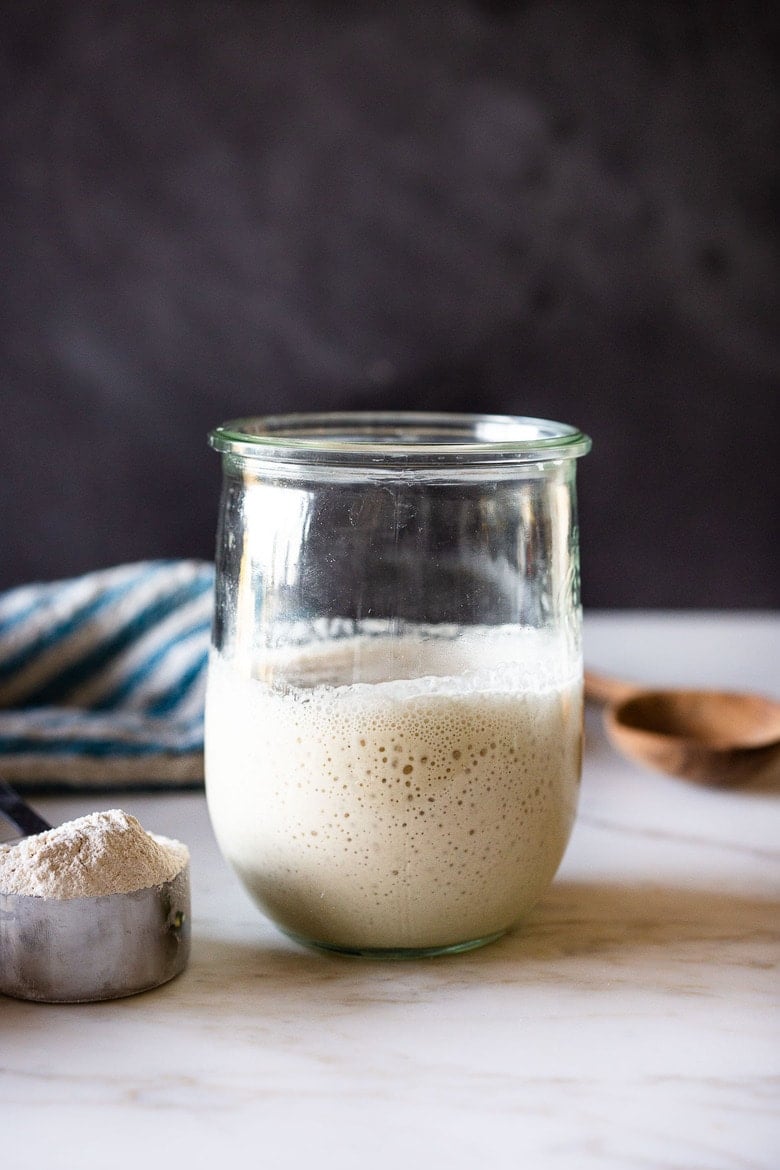
When you understand one thing through and through, you understand everything.
Shunryu Suzuki
With over 500 five-star reviews and hundreds of success stories, my chef's perfected sourdough starter guide has everything you need to make your own homemade starter. It is an easy process, and once you understand it, you’ll think to yourself, Why didn’t I do this sooner! In just six days, you'll be baking the most beautiful sourdough bread! Just read all the success stories below.
What is Sourdough starter?
Sourdough starter is a “wild yeast” made from flour, water, and the natural wild yeast in the air. With a little care and patience, it ferments, and when strong and active, just a little bit of starter replaces commercial yeast and makes your bread rise, while transforming the gluten in the bread into something more easily digestible. Store-bought yeast is not needed!
How long will it take?
It takes 6-7 days to make sourdough starter from scratch. In colder climates, it can take up to 12 days, and in warmer climates, it may only take 5 days. Once you have a bubbling active starter that consistently rises and falls, you can bake sourdough bread, typically on day 7. For a primer, watch the 20-minute Sourdough Video below, where I personally walk you through each day.
Watch: How to Make Sourdough Starter From Bread Flour
Fast forward to Specific Day by video time (using scroll bar underneath video)
- Day 1 Morning: :23
- Day 2 Morning: 4:10
- Day 3 Morning: 7:00
- Day 3 Evening: 9:12
- Day 4 Morning: 11:50
- Day 4 Evening: 13:37
- Day 5 Morning: 14:45
- Day 6 Evening: 16:50
- Day 6 Morning: 18:12
- Day 6 Evening: 20:10
Best Sourdough Starter Ingredients
Sourdough Starter Equipment
- Jar – A wide-mouth quart jar or a Weck’s 1-liter tulip jar.
- Kitchen Scale – using a kitchen scale helps measure the flour and water more accurately – optional but handy.
- Thermometer – Knowing the temperature of the starter using a thermometer gives you great information!
Sourdough Starter Ingredients
- Flour – 5 lb bag of organic bread flour (plus 1-2 cups organic whole grain flour like rye flour or whole wheat flour). All-purpose flour is not reccommended. Whole grain flour has more wild yeast- and will help jump start your starter!
- Water – filtered water, tap water, or mineral water (specifically, San Pellegrino, for the correct mineral ratio). Distilled water does not have enough minerals.
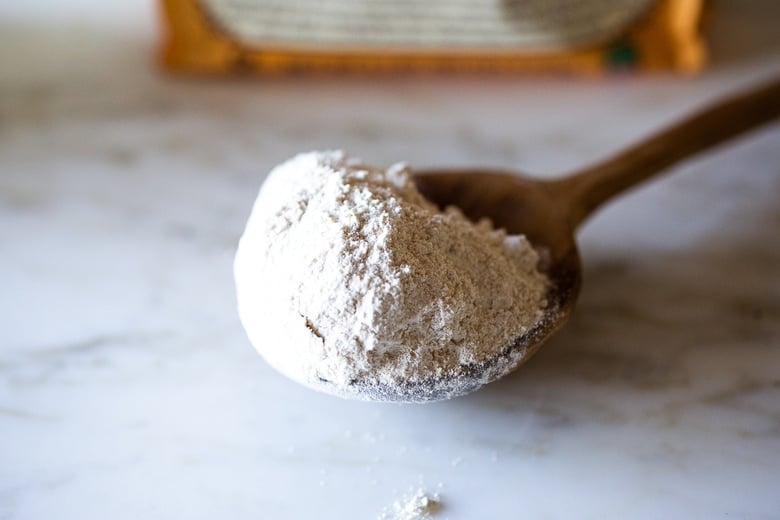
Understanding Your Sourdough Starter
The secret to making sourdough starter is understanding the process, your environment and your starter’s needs. Each starter is different and unique. Here, we’ll show you what to look for and most importantly, why.
- Think of sourdough starter as a yeast. Only in this case, instead of buying a packet of yeast from the store, you are making your own living “wild yeast” by fermenting flour and water. Once it’s bubbly and happy, it is very much like a very low-maintenance pet. Yes, you can even name it. Mine is called Vita.
- You must feed it (stir in a mixture of flour and water) once a week to keep your pet active and strong. We will show you how to tell when it is hungry and when to feed it.
- Some people believe that bread made with sourdough starter is actually better for you than bread made with yeast. Here and here are a few articles to get you started on your own research. While I’m not sure if this is scientifically proven, I do know that bread made with sourdough starter, tastes infinitely better, feels easier to digest, and has more complexity and better texture than bread made with commercial yeast. So if you are a bread lover, this is absolutely the way to go, as far as the quality of your finished bread.
How to Make Sourdough Starter from Bread Flour
*See the recipe card for detailed instructions.
For your first measurement, weigh the flour using a kitchen scale so you can get an idea of how the mixture should feel. Do not weigh the measuring cup! It should be like a thick paste, like peanut butter. If you need to add a little more water to incorporate the flour, that is OK too.
Day 1: Starting in the morning or at night, using a wide-mouth quart jar, tulip jar, mix 1 cup whole grain flour (120 grams) with 1/2 cup filtered water (120 grams) using a fork, making sure you’ve incorporated all the dry flour.
Place the lid lightly on top (using the Weck jar lid is really handy here) or a wet towel to keep moisture in, or plastic wrap- and let sit at room temperature (70-ish degrees) on the kitchen counter for 24-48 hours. If you are unsure how warm it is, use a kitchen thermometer and check it a few hours later. It is best at 70-75°F.
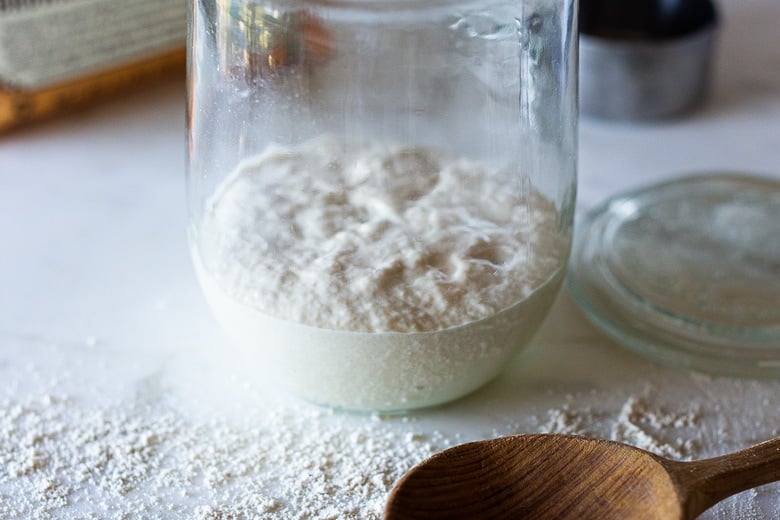
Day 2: After the first 24 hours, there may or may not be a bit of bubbling. Let the mixture rest until you see activity (bubbles or rising). Sometimes this takes 36 hours or even 48 hours, especially if the weather is very cold. When you see active bubbling, discard all but 1/2 cup of the starter (4 ounces).
To the remaining ½ cup of starter, stir in 1/2 cup lukewarm water (120 grams), and mix well with a fork. Add 1 cup of organic bread flour (120 grams) spooned and leveled. Stir until combined. Again, it should feel like a thick paste. If overly dry, feel free to add a bit more water. Cover again and allow the mixture to sit at room temperature for another 24 hours.
Day 3: After 24 hours, hopefully, you will see some bubbling or rising, and if not, let it go longer until you see some activity. Be patient. Depending on how warm your house is and how active your starter, you may need to feed it less often or more often, depending on when it gets “hungry”.
How to Know when to Feed your starter
Only feed your starter after it has peaked or looks “hungry”. Feeding it when it is “not hungry” will basically dilute all the growing yeast and make it lethargic. Better to underfeed than overfeed. How to tell if it is hungry?
- Look for “slide marks” (be sure to use a clean jar so you can see these clearly-see photo below).
- Thin and runny. The starter is liquid enough to pour out of the jar (when at room temperature).
- There is liquid at the top of the starter- a clear sign of hunger!
- Smells like acetone. The starter has processed all of the previous feeding and needs to be fed again.
In the photo below, the starter “peaked” at the top line, then slid down. I call these slide marks- indicating the starter is hungry.

This might be 12 hours, it might be 14, it might be 18, or 24, depending on the temp in your house. In very warm climates, it may only be 6-8 hours. In winter, this may take 36 hours. It is better to underfeed rather than overfeed.
For each feeding, discard all but 1/2 cup of the starter (keeping roughly ½-cup of starter in the jar). Add 1/2 cup water and 1 cup bread flour (spooned and leveled). Mix well, cover, and let this rest at room temperature for 12-24 hours or until the starter looks “hungry” again before repeating.
Day 4: Feed 1-2 times a day (only feeding when hungry), discarding all but 1/2 cup of starter each time. Feed 1 cup of bread flour and 1/2 cup of water.
TIP: It is typical on day 4 for the starter to slow down and stall a bit. This is OK. Just keep going, be patient, and look for the hunger signs, and only feed when clearly hungry. Hopefully, you’ll begin to see some rising and falling. It’s helpful to put the starter in a clean jar each day and mark the beginning level (with a sharpie, string or rubber band) so you can easily see this.
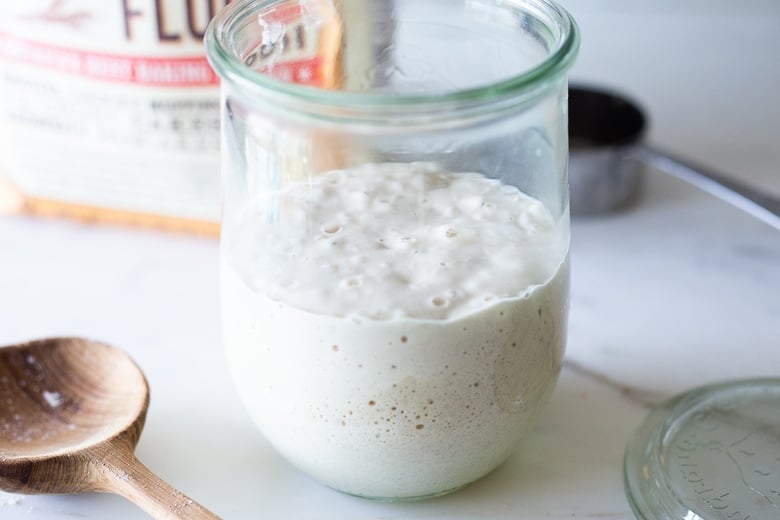
Above, you’ll see it peaking, and below, you’ll see it deflating and getting “hungry.” There may not be too much difference in the beginning, so look closely.
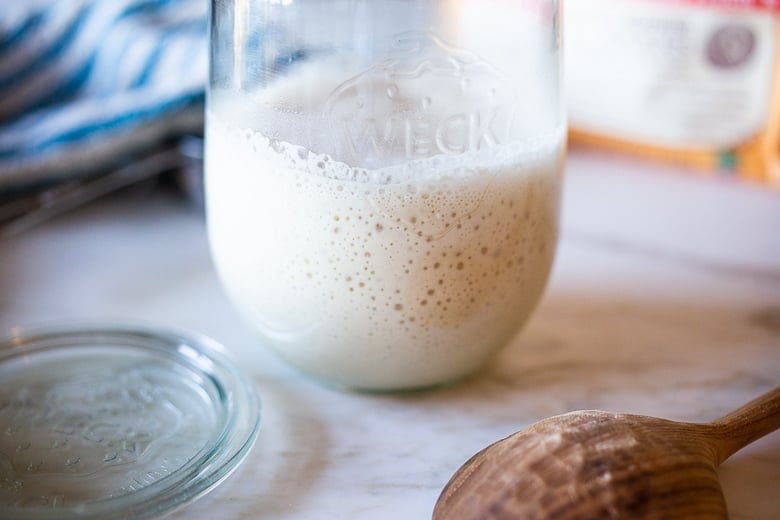
Understand that your starter has a schedule of its own; it is a living thing, so watch it and pay attention.
If your starter is not rising and falling, look at its consistency. As it metabolizes the flour and gets hungry, it will get runny and liquidy, like to the point where you can pour it right out of the jar. If it is still thick like paste, it’s not done metabolizing (eating) the flour.
Day 5: Feed again, 1-2 times, discarding all but a 1/2 cup of the starter each time. Add 1 cup of bread flour and 1/2 cup of lukewarm water. The starter should look visibly active, bubbling, rising, hopefully, close to doubling in size.
*Repeat day 5 until the starter is rising and falling predictably and is close to doubling in size within 6-8 hours.
If your starter is not rising but there is evidence of hunger (runny or liquid at the top), try these three things:
- Substitute 1/4 cup whole grain flour (add to ¾ cup white bread flour) on your next feeding.
- Use mineral water like San Pellegrino instead of water.
- Stir the starter a few times after feeding to allow more wild yeast from the kitchen to get inside.
DAY 6 Morning: Baking day! Give it one last feeding in the morning: this time discard all but a 1/3 cup. (The reason we are changing this to 1/3 cup is to feed it a little bit more.) Add 1 cup flour (120 grams) and 1/2 cup water, stir, and place it in a clean jar so you can see the activity clearly. You can use a Sharpie or place a rubber band around the jar to mark the beginning level.
How to Know When Your Bread Flour Sourdough Starter is Ready to Bake Bread
The starter should double in volume within 6-8 hours of feeding.
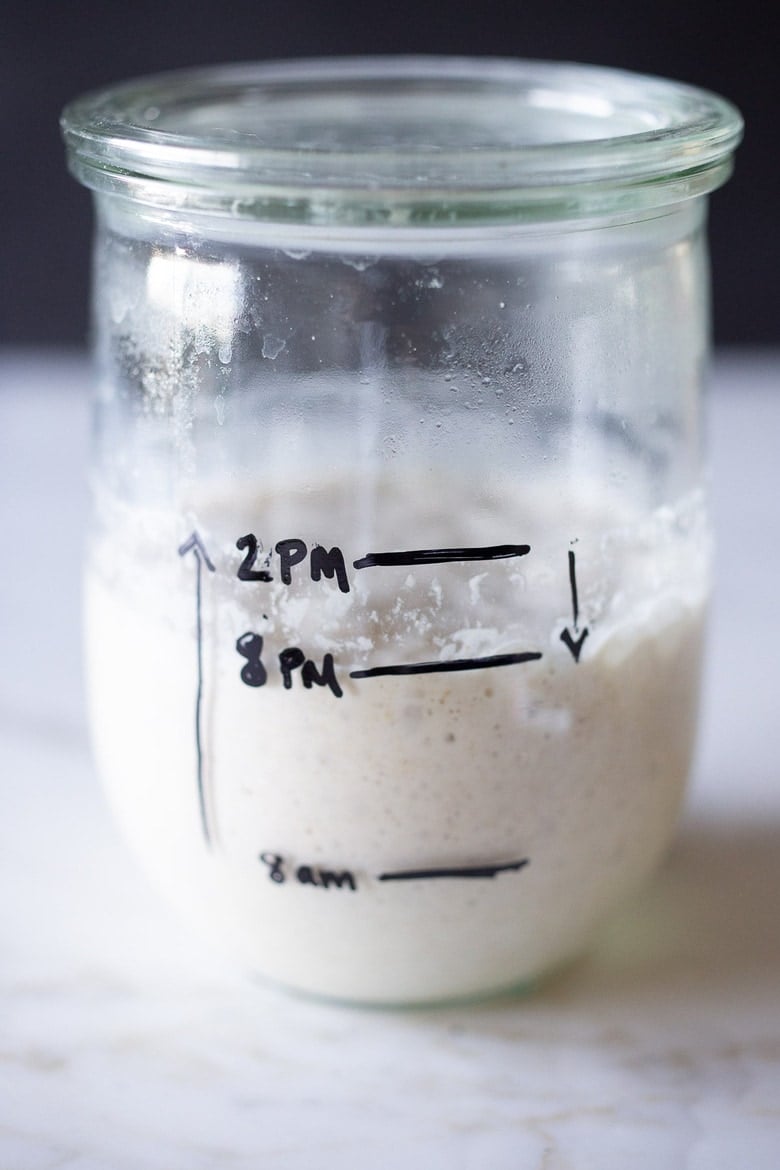
In the photo above, on the 6th day, the starter was fed at 8 am, it peaked around 2 pm, then it started deflating, and by 8 pm, it was “hungry” again. See those downward “slide” marks on the jar?
Do the Float Test
When the starter is at its peak, or just after, place a teaspoon of starter (just from the top, don’t stir it down) in a glass full of water; it should hopefully float. If it floats, success! Congrats. You can now make our sourdough bread…tonight!
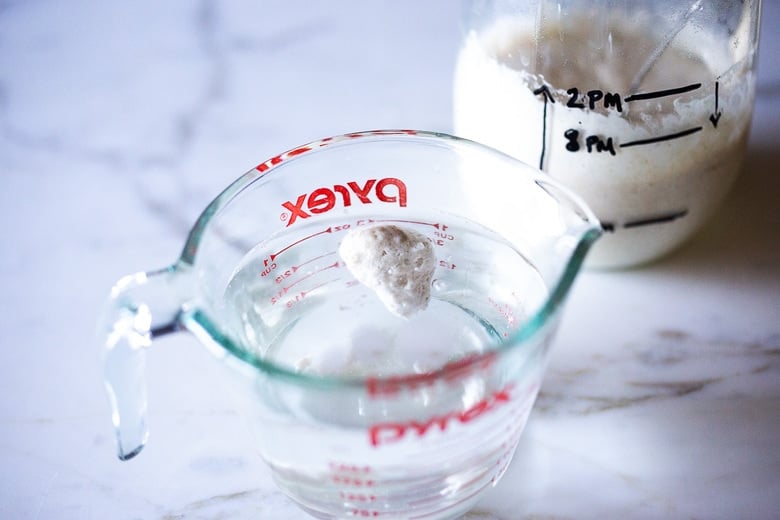
My Best Sourdough Baking Tip. When baking bread, always use a hungry starter that has already peaked.
STARTER DOES NOT FLOAT? If it doubles in size but does not float, you can still try baking a loaf if it doubles within 6-8 hours of feeding it.
At this point, if your starter does not double in size within 6-8 hours of feeding, don’t give up! Often, it just takes longer, especially during the winter months. Continue feeding one to two times a day until you see a consistent, predictable rise and fall.
Read the troubleshooting section. If you need to take a break, put it in the fridge and try it again up to a week later. Don’t toss it!
Day 6 Evening: Let’s Bake! Use 1/3 cup starter to make this sourdough bread recipe and place the remaining starter (or if not making bread, place all of it) in the refrigerator, and feed it at least once a week, reserving ½ cup starter, before feeding it the usual 1 cup bread flour, 1/2 cup water.
TROUBLESHOOTING the Best Sourdough Starter
- SMELL: Starter should smell sweet, tangy, earthy, like a wet horse – not “bad”. If it really smells foul or unpleasant, you may have used an unclean jar, an unclean utensil, or somehow introduced other bad bacteria. I would start over.
- NO ACTION: On day 4-5 it is typically for it to slow down. If your starter is not rising at all but there is evidence of hunger (liquid at the top, or bubbles) try 3 things. First substitute 1/4 cup whole grain flour (add to ¾ cup white bread flour) on your next feeding. If no rise, then try using mineral water, specifically San Pellegrino instead of water. San Pelligrino specifically has the right mineral ratio, I have great luck with it. Others not so much! Also try stirring the starter a couple of hours after feeding, a couple of times throughout the day to allow wild yeast from the room to get in there. Lastly, you could try pineapple juice instead of water.
- FLOUR: Try to use fresh milled whole grain flour to start, then organic BREAD FLOUR. The more wild yeast in the flour, the better your starter will do, so smaller brands like Bob’s Red Mill seem to do better than bigger conventional brands that have been overly processed. It is totally OK to mix flours and to switch them up- this adds different kinds of wild yeast- a good thing!
- DO NOT overfeed. For example, maybe feeding 2 x day at 12-hour intervals is too often. You want to feed after the starter has peaked, then deflated (see photo above- you’ll see some slide marks on the jar) and this tells you that it is hungry. If you feed the starter before it has had a chance to metabolize (or eat) all the flour (before peaking) and then you discard part of it, and feed it again, you are actually diluting all that amazing bacteria, weakening your starter. So it’s all about watching your starter in your home. If you are not seeing rising and falling, but notice the starter just gets liquidy, this too is a sign of “hunger”. Or if it gets runny enough to pour out of the jar, another sign it is hungry. There are lots of variables here. Just be patient, pay attention and watch. This is a living thing- it doesn’t care about time schedules and recipes or what it “should” do. It will “eat” when it is “hungry” and sometimes it likes to eat slowly. 😉
- TIME: It may take longer than 6 days in colder environments. Use a kitchen thermometer and take its temp. Is it over 65F? Find a place where it can be warm. In the oven with the light on, or in an upper cupboard (heat rises). Sometimes it takes 12-14 days! Be patient, keep going. If it is doing absolutely nothing, leave it out on the counter for 24-48 hours and see what happens. If you run out of flour or need a break, don’t just toss it; put it in the fridge and see if you can get it going a few days later.
- ACIDITY: If you still can’t get that starter going, some people recommend subbing pineapple juice for the water for one feeding- raising the acidity level. My good friend just tried this and it got hers going.
- LIQUID: If you see any liquid at the top of your starter, it means your starter is hungry. So, yes it’s still alive which is a good thing! You can stir the liquid in, or pour the liquid out, either way, but feed it. This is a sign that you may need to feed it more often.
- MOLD: if you see any discoloring or mold on the surface, starter was probably contaminated. If it is only on the surface, it is probably ok to save. Scrape it off, save 1/2 cup of the underneath starter, and keep going, using a clean jar. Feed, smell, use your best judgment.
- FLOAT TEST: Try testing when your starter is peaking. Take a spoonful from the top without stirring it down. If your starter is rising and falling consistently, but not passing the float test and it has been over 8-10 days, just try baking a loaf. People are having luck with good loaves without passing the float test. It may be the flour…
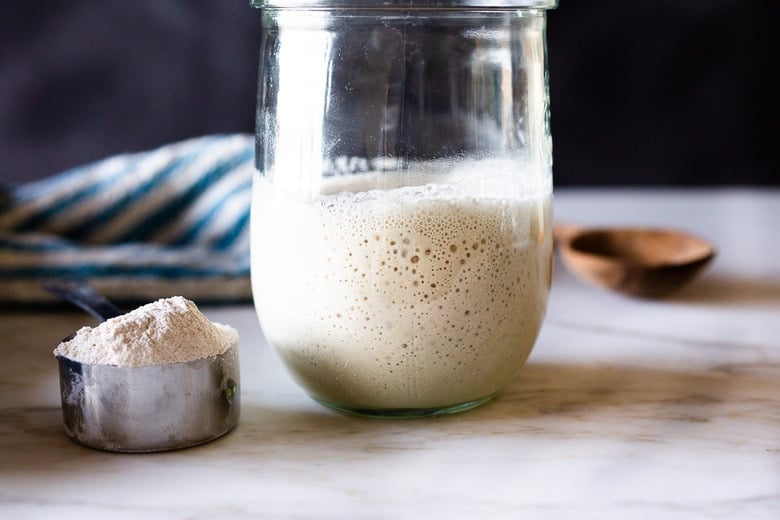
Sourdough Starter with Bread Flour Storage Tips
- REFRIGERATE & FEED AT LEAST ONCE A WEEK: Pick a scheduled day and try to stick with it, always reserving 1/2 cup and feeding it 1 cup flour and 1/2 cup water. Discard the remaining, give it away, or keep the discard in a separate container for sourdough pancakes, sourdough buns, banana bread, biscuits, etc. I usually don’t feed the discard unless I give it away.
- If you forget to feed it one week, it is most likely OK; feed it 1-2 times a day for 1-3 days in a row to revive it (keeping it out on the counter) until bubbly and active and doubles within 6 hours. I’ve left my starter for a month on vacation (in the fridge) without feeding and simply revived it by feeding it 3 days in a row, 1-2 x day. It’s surprisingly hard to kill. You can also freeze it for more extended storage.
- This batch of starter will allow you to bake 2 loaves of bread per week with enough left to feed for the next week. If you want to bake more often, you can keep it out and feed it 1-2 x daily. Or if baking every few days, you can pull it out of the fridge, feed it 10 hours before using, leaving it out, use what you need while it is peaking (or slightly after), then put it back in the fridge that evening. Do the same thing a few days later when ready to use again. So this would be feeding 2-3 times a week, best if baking 4-5 times a week.
- If you are not actively baking, you can maintain a smaller amount of starter using the same ratios.
- You can also freeze the sourdough starter if you’re leaving on a long trip.
FAQs for this Sourdough Starter Recipe with Bread Flour
Yes. While you are building your starter, during the first week, it is the simplest, easiest, fastest, and most economical way to create a healthy starter. (Or save it separately -in the fridge- and use it in Pancakes, Waffles, Buns, or Biscuits. ) This is because you always have to feed it two times its volume in flour. For example-if you kept all the 1 1/2 cups of starter, you would have to feed it 3 cups of flour (instead of keeping just a 1/2 cup and only feeding it ONE cup). Discarding will shorten the fermentation process, require less flour in the long run, and create a stronger starter. Once your starter is “established” after the first week- then you can give it away to friends or use it in pizza dough, pancakes, etc).
This recipe for Sourdough Starter takes 6 days (or up to 12 days if it is very cold where you live).
The only ingredients you need to get started are flour (bread flour and whole grain flour) and water.
What is the biggest mistake you can make with your sourdough starter?
The most common mistake is overfeeding, which weakens your starter instead of making it stronger. The secret is to watch for signs of hunger-bubbles slowing down, slide marks in the jar, or liquid on top-before feeding. Once you learn to read your starter's natural rhythm, it will stay bubbly, active, and ready to bake with.
It's surprisingly simple to make a sourdough starter! The process is hands-off and only takes a few minutes each day. The key is consistency: feed it regularly and keep it at a steady temperature. Once you get into the rhythm, caring for your starter becomes second nature, and you'll be rewarded with a healthy, bubbly culture for all your baking.
How to use Beginner Sourdough Starter
- See all our Sourdough Recipes!
- Sourdough Scones
- Sourdough Crackers
- Sourdough Biscuits
- Sourdough English Muffins
- Sourdough Tortillas!
- Vegan Banana Bread
- Overnight Sourdough Waffles
More from Feasting At Home
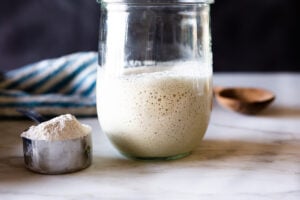
Sourdough Starter Recipe with Bread Flour
- Prep Time: 30
- Cook Time: 6 days
- Total Time: 144 hours 30 minutes
- Yield: 1 ½ cups 1x
- Category: sourdough, fermented, cultured, bread, baking,
- Method: fermented
- Cuisine: bread
- Diet: Vegan
Description
How to make your own Sourdough Starter (see the step-by-step video in post) using simple ingredients with no special equipment, in 6 days, that can be used in sourdough bread. Sourdough Starter is a wild yeast, made from fermenting flour and water.
Ingredients
- 120 grams whole grain flour (whole wheat flour, rye flour, or freshly milled flour) 1 cup, fluffed, spooned and leveled
- Organic White Bread Flour (5-10 lb bag ) I like Shepherd’s Grain or Bob’s Red Mill.
- 120 grams Water per feeding (1/2 cup water)
Instructions
-
- Day 1: Starting in the morning or at night, using a wide-mouth quart jar or Crock or Glass Measuring Cup mix 1 cup whole grain flour (120 grams) with 1/2 cup (120 grams) filtered water using a fork making sure you’ve incorporated all the dry flour. For your first measuring – it is a good idea to weigh the flour, using a kitchen scale so you get an idea of how thick it should feel. It should be like a thick paste. Thick like peanut butter. If you need to add a little more water to incorporate the flour, that is OK, but be precise with the flour. Place the lid on top (using the Weck jar is really handy here) or a damp towel to keep moisture in, or plastic wrap- and let sit at room temperature (70-80 degrees) on the kitchen counter for 24-48 hours, or until you see some bubbling. If you are not sure how warm it is, use a kitchen thermometer and check it a few hours later. See notes for TEMPERATURE.
- Day 2: After the first 24 hours, you may or may not see a bit of bubbling. I prefer to let this rest until I see a tiny bit of activity (bubbles) and sometimes this takes 36 or up to 48 hours. So start “day 2”, when you see a little bit of bubbing. Discard all but 1/2 cup (136 grams) of the starter. (See notes for discard). Add to the remainder, 1 cup of white bread flour, (120 grams), spooned and leveled, and 1/2 cup filtered water (120 grams), mixing well with a fork. Place the lid on loosely again and allow the mixture to sit at room temperature (70-80F) for another 24 hours.
- Day 3: By the third day, you should definitely see some bubbling- and if not, let it go a bit longer. Depending on how warm your house is and how active your starter, you may need to begin feeding more often, or even move to two feedings a day roughly 12 hours apart, like in the morning and at night. In a nutshell, you want to feed the starter only after it has peaked (metabolized all the flour from the last feeding) and has started sinking down or gets liquidy- this is when it is hungry! This might be 12 hours, it might be 14, it might be 18, or 24, depending on the temp in your house. In very warm climates it may only be 8 hours. It is better to underfeed rather than overfeed here. For each feeding, like before, discard all but 1/2 cup of the STARTER (keeping roughly ½-cup of starter in the jar -4 ounces or 136 grams) Add 1 cup Bread Flour (spooned and leveled) and 1/2 cup water to the 1/2 cup starter and let this rest at room temperature for 12-24 hours or until the starter looks “hungry” again before repeating.
- Day 4: Feed 1-2 times, discarding all but 1/2 cup of starter EACH TIME. Feed 1 cup bread flour, 1/2 cup water. Look for the hunger signs. Hopefully, you’ll begin to see some rising and falling. It’s helpful to put the starter in a clean jar and mark the beginning level (with sharpie, string or rubber band) so you can easily see this. ***If for some reason your starter looks like it is still rising at the time of second feeding (at night) and there is no evidence it has fallen or no slide marks, it is still “eating” so skip this feeding and feed first thing in the morning. AGAIN, Feeding it when it is “not hungry” will basically dilute all the growing yeast and make it lethargic. Better to starve than overfeed.
- Day 5: Feed again, 1-2 times, roughly 12 hours apart, or when hungry, discarding all but a 1/2 cup the starter EACH TIME. 1 cup bread flour, 1/2 cup lukewarm water. The starter should look active, bubbling, rising, sliding down, hopefully, close to doubling in size. (If not, repeat this day until starter doubles in size within 8-12 hours of feeding- and read the troubleshooting section.)
- DAY 6: Give it one last feeding. Discard all but a 1/3 cup. Add 1 cup flour ( 120 grams) and 1/2 cup water, and place it in a clean jar so you can see the action clearly. You can use a sharpie or place a rubber band around the jar to mark the beginning level. The starter should hopefully double in volume within 6 hours of feeding. When it peaks, DO THE FLOAT TEST: To test the starter, place a teaspoon of starter (just from the top, while it is peaking, don’t stir it down) in a glass full of water, it should hopefully float. If it does, you can make sourdough bread. Tonight! Let the starter keep resting at room temperature or a few more hours allowing it to fully metabolize the flour, perhaps sinking a little before making your dough. You want to make dough with slightly hungry starter. Place the remaining starter in the fridge and feed it in a week. You’ll have enough stater to make one more sourdough loaf during the week, and still have enough to feed. If you want to wait to make bread until later in the week place starter in the fridge. Be sure to feed it in 7 days. Read maintenance section.
- At this point, if your starter does not double in size don’t give up! Often it just takes longer, sometimes up to two weeks, especially if it’s cold. Continue feeding one-two times a day (only when hungry) for a few more days, until you see a visible rise and fall. Read the troubleshooting section. If you need to take a break, just put it in the fridge and try it again up to a week later. Don’t toss it- if there are bubbles, it is still alive.
- This batch of starter will make two loaves of bread with enough left over to feed for the following week.
Notes
- TEMPERATURE: The colder your home, the longer it will take for the starter to grow and become active (bubbles). Find a warm spot (70-80 degrees) for the best results. On the stovetop, with the light turned on, or on top of the fridge. Or in the oven with the light on. On top of a heating pad (set to low) with a towel in between). You can still make the starter in a colder home, it will just take longer- even up to 2 weeks.
- FLOUR: Always try to start the batch by using organic, freshly milled whole-grain flour (wheat or rye) because it has more wild yeast in it than All-Purpose or white flour and will get it active and growing sooner. You can, of course, continue to use whole grain, but I’ve had the best luck using organic “bread” flour for days 2 through 6. People have made a sourdough starter with All-Purpose flour- but personally, this has never worked for me– there are fewer nutrients and wild yeasts in the flour and results in a very lethargic starter. If it is your only option, try mixing in 2+ tablespoons of whole-grain (wheat or rye) with the AP flour per feeding. Feel free to use different flours or mix different flours together. It is OK to use all-purpose flour if in a pinch, but using it repeatedly will result in sad starter.
- WATER: I usually use tap water -but sometimes the chlorine in tap water can inhibit the growth of your starter. Lukewarm water helps fermentation to start faster. Sterilized bottled water is often overly sterile, and can also inhibit. Mineral water, like Perrier (carbonated is OK) can sometimes work miracles.
- HYDRATION: Hydration refers to the ratio of water to flour in terms of weight. It is a ratio. The starter is typically at 100% hydration- meaning equal parts flour and water, in terms of weight. So if you use 120 grams of water, use 120 grams of flour. This roughly translates to 1 cup of flour and 1/2 cup water. Feel free to weigh instead of measure if you want to be more precise, or want to familiarize yourself with the consistency you are aiming for. If using whole grain flours (which tend to be “thirstier”) and your starter seems very thick, it is totally OK to add more water to thin it a bit. I intentionally keep the hydration a little lower here (a thicker starter) so you can more clearly see the rise and fall “action” in the jar.
- STORING AND FEEDING: When your starter is kept cold, in the fridge, you don’t need to feed it as often- only once a week. Feel free to feed it “cold”, and put it right back in the fridge if you like. If you keep it out on the counter, you’ll likely need to feed it 1-2 x daily (or just watch and feed only when hungry). Cold slows down the fermentation, heat speeds it up.
- USING: When you need to use your starter for baking bread, feed it 10-12 hours before making bread dough, using it after its peak height. For a more “sour” flavored bread, use the starter straight from the fridge, 3-6 days after feeding. The starter gets more sour tasting the longer it goes without feeding. Feeding the starter the same day as making bread will produce a milder sourdough flavor.
Nutrition
- Serving Size: 1 tablespoon
- Calories: 31
- Sugar: 0 g
- Sodium: 0.2 mg
- Fat: 0.1 g
- Saturated Fat: 0 g
- Trans Fat:
- Carbohydrates: 6.2 g
- Fiber: 0.2 g
- Protein: 1 g
- Cholesterol: 0 mg
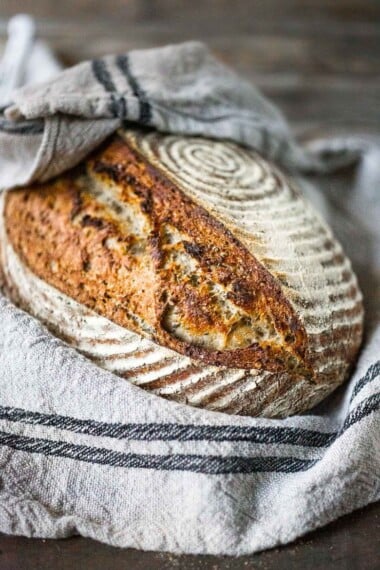

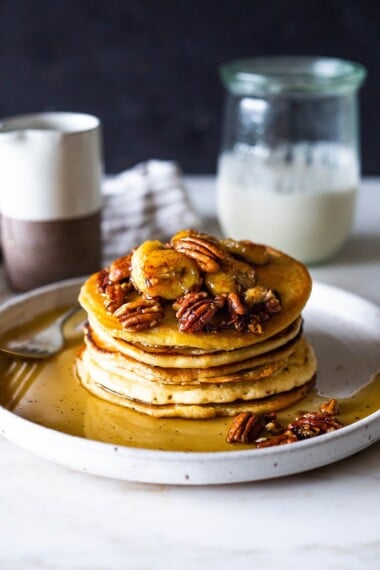
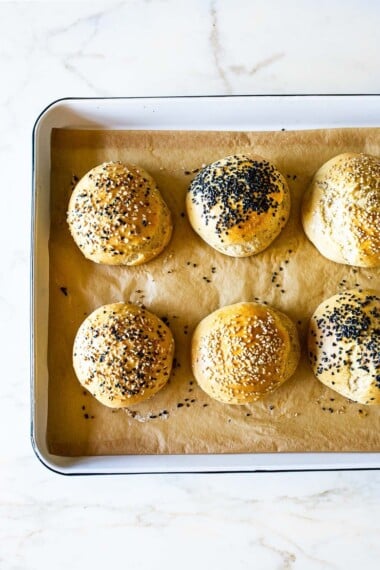




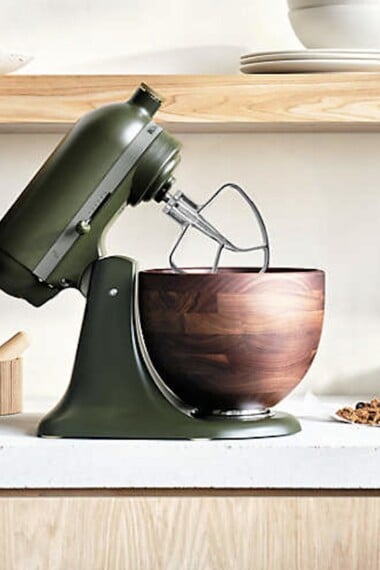


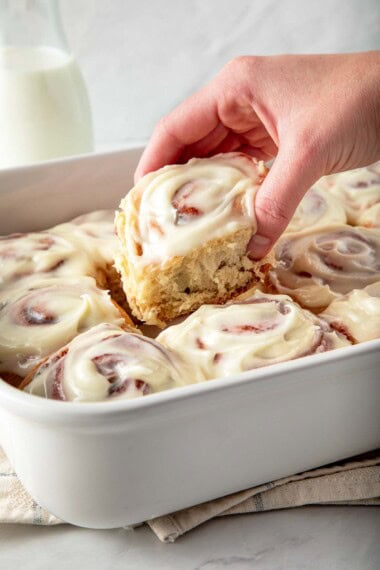


Thank you for taking the time to make this post. This is the first time I have ever made a SD starter and I feel like I must be doing something wrong…On the third day my starter overflowed. I don’t have access to larger jars so I decreased the amount of each feeding, but kept the 1:2:2 ratio. I used 25g starter to 50g each water and flour. Since I began doing this, my starter has not risen at all. It does get runny and watery and smells strongly of ferment/vinegar. I know the change in texture is another sign of hunger, but I just feel like I may have messed it up. Any advice?
Nope- you did not mess up. That is typical for it to slow down on day 3 or 4. Just go through the troubleshooting and keep going. 🙂
This is the best explained Sour-dough starter recipe, ever. When I first came to this site, I poo-pooed it because it was so much reading. I went to a couple of other sites pulse couple cookbooks, tried their way and it didn’t work. I came back to this site and tried the video first and WOW, I was so “saved” by the simplicity and easy but smart way of showing and explanation of exactly what I need to know for making the starter from the beginning to the end. Especially loved learning the rise and fall of the “peaking” definition, the more than one way of telling when to “feed” the starter, what to look out for, etc. You are a smart lady. Thank you so much for sharing.
Thanks and glad this worked for you!
I am a first-time sour-dough starter. I have been trying for over two weeks, wasting lots of flour, milk, and sugar. Your recipe and the video, by far, are the easiest to understand, and best-explained recipes. Thank you so much for sharing. Five stars well earned.
thanks so much!
Unsure of what to do……my starter was doubling for the first few days. Since Friday it hasn’t been rising like at all. The consistency does change from thick when I first feed to thin and pourable in 24 hours but I’m not seeing a rise in that time. I thought I was ready for twice a day feeds….any thoughts?
This is typical Jaime. I would try different flour- if you can find any fresh-milled? The good thing is it is digesting the flour. Are you using a clean jar so you can be doubly sure there are no slide marks? Sometimes starter likes to rise and fall when no one is watching. 🙂
Thank you! Yes, I’ve been using new jars so I can see the marks. I’ve incorporated the whole wheat flour back in for the last two days, just sticking to one feeding a day. Should I try two?
Ok Jaime. I think you should only feed it when it looks hungry. Butter to underfeed than overfeed. 🙂
Well, I caved and threw out my old starter and restarted. I bought local whole wheat flour-I think that was the game changer!
Day 6 and doubling within 5 hours and passed the float test. Tomorrow will be bread day.
Thank you for all of your help ☺️
Congrats Kaylee! 🙌
Hi Sylvia,
Thank you for sharing your recipe! One quick question…for the discard that I can use for pancakes or waffles, how long can I keep it in the fridge before using it?
You know Getta, the sooner the better! Once it sits in the fridge without being fed, it will start to look a little sad. Wait too long and the liquid will discolor- which I just can’t bring myself to use. I try to time feeding the starter on weekends, and then use the discard that same weekend to make things.
I successfully made bread and I want to make some again today. I also started starter for my daughter last week. So I fed mine and my daughter’s this morning and made some for my son.
I set the three jars out after the feeding. And two are slowly rising (I have a really cold house) but the third isn’t doing a thing! I did the feeding at around 8:30 and it’s 12:30 now.
Any idea what’s going on?
No, not sure. Strange! They are all three the same batch?
Yup all the same batch. After several more hours they evened out. It was odd. They were all in a row. I decided to leave them to get really hungry and then suck them in the fridge. Too tired to do anything today. I’ll bake tomorrow or Monday.
Question! I have bubbling after 36 hours but it doesn’t look “hungry” as in it hasn’t deflated. Should I give it its first feed because bubbles have appeared? Or should I wait until it has deflated a bit?
Maybe just wait a bit!
Thank you! It’s super bubbly. Can’t wait to see if it has deflated some after I get home from work! I’m eager to feed it!
Awesome!
Hello,
I followed your recipe exactly, and the first two days I was so encouraged by the results! On day 2 my starter exploded out of the jar (woohoo!). After it was done falling I fed it per your instructions and used a scale to ensure I measured everything correctly. However, today it hasn’t done much of anything. There is some slight bubbling on the top but it hasn’t changed in size at all. Any idea why there’s been such a drastic change overnight? Instead of feeding it on my normal schedule tonight I was planning on giving it more time and checking on it in the morning. Any advice is greatly appreciated.
Thank you!
Teryn
That is pretty typical Teryn! Yes, just wait until you see signs of hunger before feeding again. 🙂
Teryn, when you fed yours for the first time did it appear hungry? I started mine Wednesday night and it has at least doubled in size but hasn’t deflated at all yet. So it doesn’t look hungry. I’m wondering if should wait for it to deflate or just feed! I think mine will bust out of the jar if I leave it overnight lol
Hi there,
I have been working on my starter for 2 weeks. Yesterday, I did the float test and it floated but it is not doubling it’s size in 6 hours. What would you recommend? Also, I have been using a mix is the whole wheat pastry flour and organic I bleached bread flour. Is that okay? It seems to I flare the most with this combination. Thanks so much!!
Hi Brea -How long does it take to double?
It has been taking 12 hours. I do live in Ohio and it’s quite cold outside but our house is set around 70! Thanks for the response.
My starter Rye in Brod n Taylor proofing box set at 27c now for weeks still just show bubbles but not peaking. Temp is warm and consistent. Feeding consistently every day 25gm rye and 25gm bottled water and discarding 50+gm each time. Notice a thin skin/crust each day and i wonder if that is like a canopy stopping the rise of bubbles? Just big bubbles and no more than that.:(
I have read that rye flour would be a super starter and even the proofing box has not helped. Any thoughts what I am not doing right? Thank you.
Hi Rosalind, I would try mixing things up. Try adding, or blending with other flours (you can always switch back to all rye later) and perhaps just try tap water. I know, I contradict myself but sometimes bottled water can be “too sterile”! Give it a little change. Also try covering with plastic wrap or beeswax paper- sounds like your starter is drying out.
Hello. My starter is exploding out of the jar. I use the same jar you use in your video. It overflows and does not sink back down. What am I doing wrong? Is my starter ruined. I am on day 5.
Wow! This is a good thing. Good for you…you must have really good flour… do you mind sharing the brand? You are doing everything right- you have very happy starter! You may need to get a bigger jar or container, or try to stir it down as it hits the top.
Thank you for your reply. I am using King Arthur Bread Flour. I did use some older Rye flour to start the starter, as you suggested. I have my first loaf from this new starter in the oven now.
One quick question…I feed the starter this morning. Let it sit out for about 3 1/2 hours and it has doubled. Can I just put that in the fridge now?
yes, you can put it in the fridge now. 🙂
Came here to ask the same thing. After a very slow day 3, thinking I must have failed, on day 5 it started going wild. Thanks for all the reassurance in this recipe.
Glad we are in the same boat! It took a few extra days before my starter floated. Guessing your’s will do the same. My first loaf is in the oven now. Good luck with yours. Enjoy each bite.
What if you don’t bake it on the 6th day? Will it go bad if you don’t? Is there a way to know if it’s ready to bake. I live in a colder environment. I started mine on 2/8 and it didn’t get hungry until 2/11. So within the 6 day time frame it won’t get as many feedings. Is that ok or do I need to go an extra couple days?
Toni- it is Ok if you don’t bake on the 6th day. You can go longer if needed. If it doubles within 6 hours of feeding feel free to bake, otherwise keep going.
I’m attempting my first sourdough bread, and am only on day two of my starter (began yesterday at 7:30 am). Today after feeding again at 7:30 am, it rose very, very high, almost more than doubled, and now has shrunk down. Do I need to feed it again or just leave it till tomorrow (day three)?
I would feed it. 🙂
During the maintenance phase, do you suggest continuing with bread flour or is organic unbleached white flour ok?
You can try it and if it starts getting lethargic, then switch it up.
Oops. I got in a hurry and fed my starter without removing any. What do I need to do? Thank you.
Oh Shoot Brenda. Well I would let it get hungry- look for the signs, and just continue on, be doubly sure to discard. 🙂
Thank you!
So, on my last day I accidentally kept 1/2 cup instead of 1/3 cup. I fed the normal 120g flour and water- what would I need to add to fix it?
I would not worry about it, no need to fix. 😉
I just did a float test and it worked! Very clear, easy to follow directions. I started my first loaf tonight and can’t wait to try it. Do I feed it one more time or do I put it directly in the fridge for a week? Thank you!!
Just put it in the fridge. 🙂
OK I think I’ve come to the end game. I fed 1/3 c this morning and it’s rising now — getting close to sinking.
I seem to have missed an instruction or misunderstood. When I use it, do I feed it right after? Do I leave it out or put it in the fridge after. If I don’t make bread when do I put it in the fridge? When it sinks? Thanks. You’re so helpful to everyone! You’re a star ⭐️
Awww, thanks! Gaylyn, appreciate this. Check the “maintenance section” of the post. Lots of helpful info there!
Sorry I must be stupid because I reread the maintenance section and still wasn’t sure what to do. I decided not to make bread right away because I didn’t know whether to feed it after or just refrigerate the first time. I saw the comment above which was asking whether to feed after making bread or wait so that is now answered.
Thanks so much. You’re very reassuring and detailed and that’s great.
I find the repeated instructions a bit confusing. Is the video on YouTube? I couldn’t find it. The imbedded video, which is really good, can’t be forwarded and is really frustrating if you want to look at a specific section.
Hi Gaylyn, It can be a bit confusing. You can either make the bread right away,(and refrigerate the remaining starter without feeding it again for a week) or place all the starter in the fridge and make bread later in the week. Just be sure to feed the starter in 7 days. I’m not sure I am answering your question. The timestamp for the video sections are listed below the video. You should be able to forward to the section you are looking for.
Thanks for all the handholding from me and I’m sure from all the others.
I made a mistake not reading the bread making instructions before I finished with the starter.
I don’t have a Dutch Oven (or any substitute) so into the fridge it went until I get one. I shall continue to feed weekly.
I ordered one today which should arrive just in time to make some bread for my daughter who is scheduled to visit just after and has requested sourdough bread.
I know the times are thee but on my phone there’s no way to get to forward the video. 🤷♀️
Oh ok interesting Gaylyn! Maybe best to watch video on a laptop? Good luck and let us know how it goes after you get your dutch oven.
Hi! The recipe to create the starter worked beautifully. Where I wasn’t sure of was the feeding after storing it in the fridge. I gave some away to friends and they both said it didn’t do anything after feeding it from the fridge. I looked up on the King Arthur website and it says to let it sit out a couple of hours after taking it out of the fridge and feeding it before placing it back in the fridge. Is that what you do? Thanks so much, this is so much fun!
You can do it either way. If you feed it cold from the fridge, it just takes a bit longer. But I do it both ways.
Hi, Could you tell me why you decrease the starter from 1/2 cup to 1/3 cup on day 6? And what difference it makes using 1/3 or 1/2 cup after you refrigerate it. Thanks. It was the only thing I didn’t understand in your otherwise REALLY clear description.
Basically, it is to give the starter an extra boost of “food”. 🙂
Thank you so much for this video and article. I followed the instructions on the King Arthur site. I could not seem to get my sourdough going. I religiously fed it once a day and then on the third day twice a day and it still didn’t seem to be acting correctly. After watching your video I realized I was feeding it too often as my house is cold. Today is day 8 and I have not fed it for over 24 hours, it is still slowly rising and has not peaked and fallen. Tomorrow morning I will feed it, let it peak and fall.i am hoping that I can go back to 2 times daily, but if not at least I know what I am looking for now.
Thanks
Great Mary- yes, it can be quite challenging in different environments- so many variables. But if you understand the general idea- then it all becomes clearer!
Hi Sylvia,
My starter had a significant rise and fall on the morning of the 3rd day, 12 hours after the feeding the previous night. I went ahead and fed the starter the normal way and was wondering whether I should’ve waited the full 24 hours or was right to go ahead and feed it… Thanks for the help!
Hi Preston -It really jsut depends on your starter- and without seeing it, I can’t say. Just look for the signs of “hunger”, and wait to feed until you see them. 😉
Oh no! I dropped my starter. I had it in front of the fireplace (not close) and I was picking it up to check it. It was rising nicely but not ready to feed. (It was fed this morning). It had t quite doubled. So now it’s deflated quite a bit.
My plan is to just leave it and see if it starts rising again. Based on “better to starve than overfeed” unless it’s obviously hungry I’ll leave it until tomorrow. I‘be lost track of what day I’m on but our house is very cold so it’s not been fast.
Sorry you dropped it and but happy it didnt break!
I had to wait 2 days from day 1 to 2 because nothing really happened after 24 hours so I waited 48 hours. On day 2 I fed it this morning and it like tripled in size 12 hours later! What does that mean? I felt like it was hungry so I fed it after 12 hours on day 2. Is that okay?
Sounds good Jorie. Just always remember to feed after it has sunken down a bit. 🙂